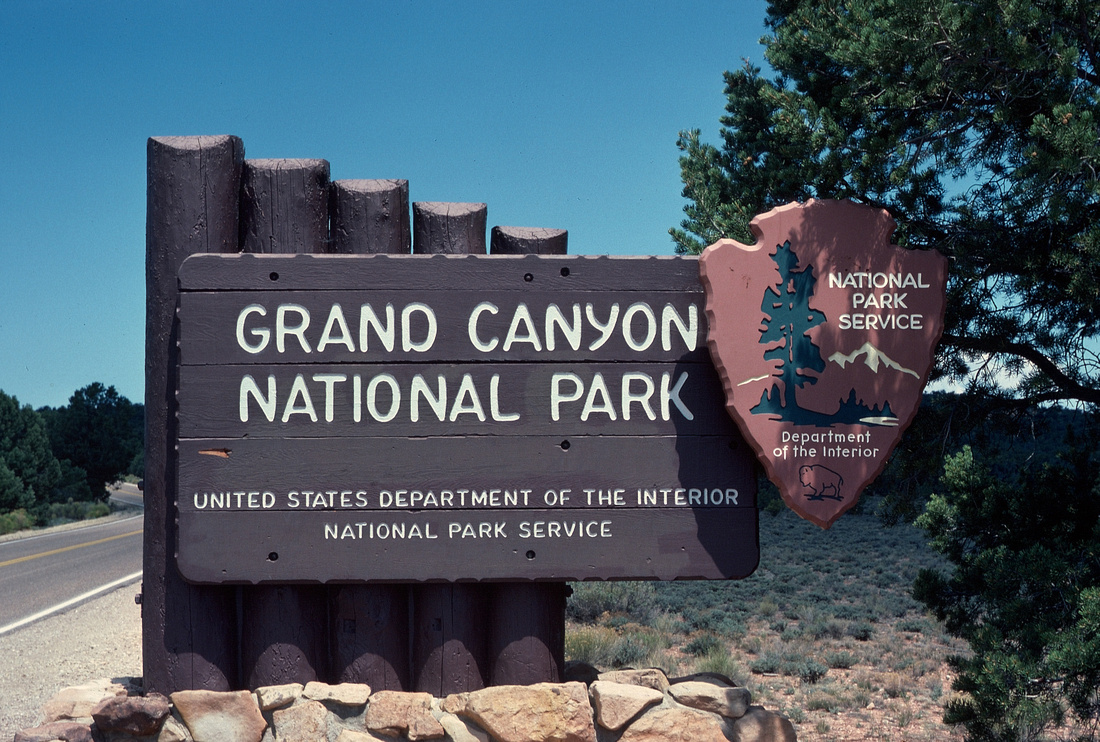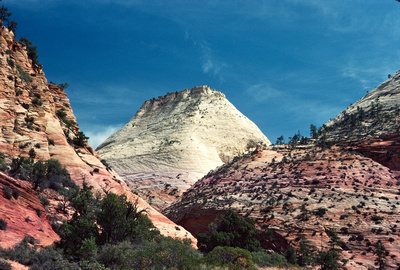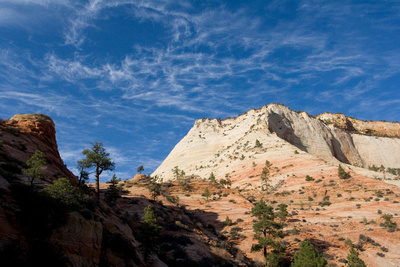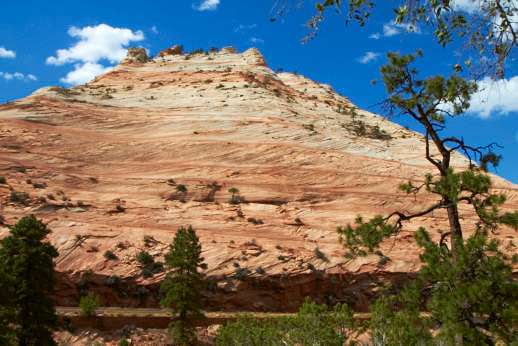With thousand of pictures... where are they?
Unlimited storage may mean unlimited disorganization
We have been shooting with cameras for over 100 years, between Louise and me. Fortunately, all the bad pictures are now lost. We prefer to think that the one we have are the good ones!
Still, between the scanning of older prints and the shooting of new images, the inventory goes up. Baby pictures, trips and landscapes, street shots, the list goes on. (I am using the word pictures to include videos, when necessary.)
Zenfolio just published a book – Zenfolio Book for Photographers which helped me to make some decisions about photo storage and organization.
Look and Feel
We are not professional photographers, but we strive to create good pictures and we hope that those friends whom we share these have a good experience and will come back to see more.
To achieve a good experience, the site that contains the pictures must reflect on vision and who we are. The look and feel of the site is really telling who we are, both in words and in pictures.
Finding Pictures
We currently have over ten thousand public pictures. Not that many, but enough to get lost looking for something that interest you, our friend.
These pictures are currently organized as:
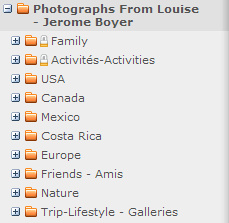

Under each main entry, there is a hierarchy that captures additional details like:
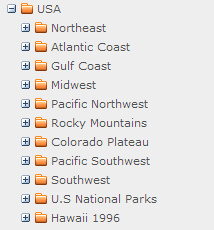

Under the U.S. National Parks you will find Collections or Galleries like:
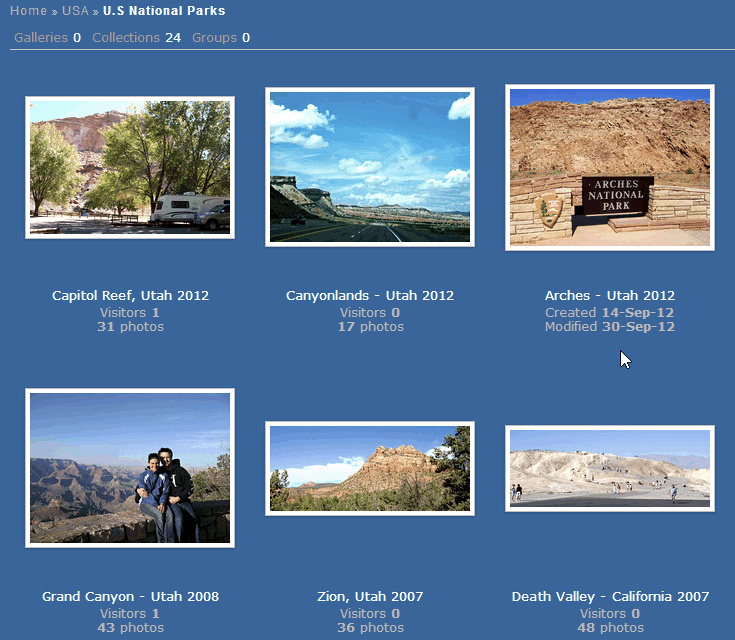

Note: this last screen shot is from the public web site. The preceding ones were from the management side of our Zenfolio site. The hierarchy is displayed on the menus:


When time is limited, this type of organization requires too many clicks to find pictures you may be interested in!
Invitation to see pictures
Most of the time, we invite our friends to see some recent albums we prepare from a trip. This invitation may look like:
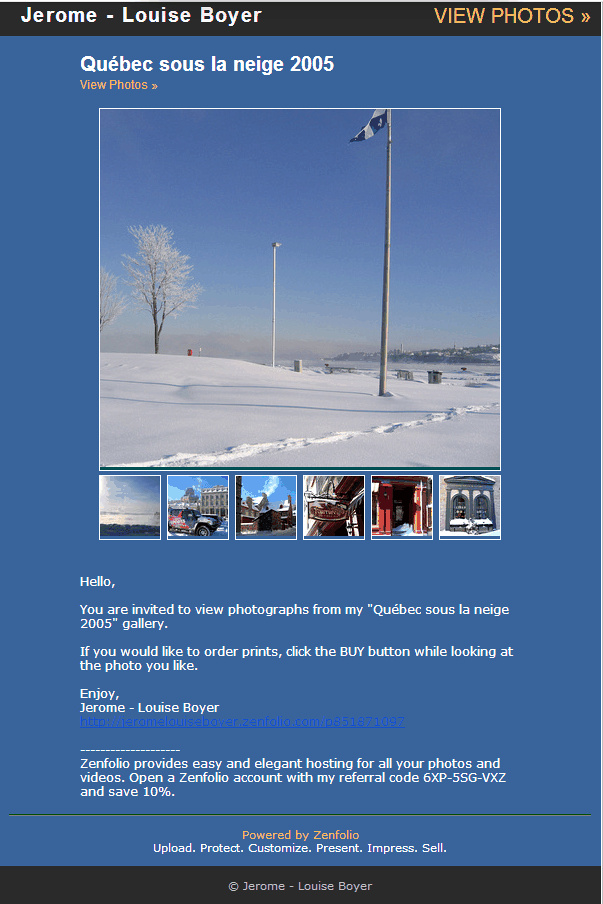

Unless one has time, or wants to find something specific, a quick slideshow will complete the invitation. Why would one go back to the main menu… and try figuring out what to look for? If you are curious, this is the Main Menu:
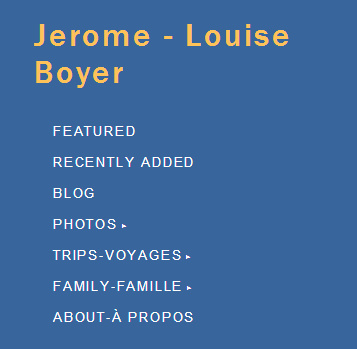

FEATURED may be a good way to start as we constantly update the Galleries and Collections in this menu.
RECENTLY ADDED will show you our latest additions. You may have missed some invitation, time to catch up.
Enjoy. Thanks for watching.
Coming next: Using the Search tool.
It has been over a year...
Discipline. The common criterion of success in any endeavor
I failed on that count.
For months, we have shot pictures, travel many kilometers, enjoyed good time with friends… and we only have shared a few galleries – well captioned by Louise. But I lacked the discipline to expand these galleries with blogs to express thoughts not conveyed in the pictures.
2013 was a year of decision
Let’s reflect on 2013. It was a successful year, with two trips up North, visiting our families in Burlington and Vancouver.
It was a successful year as our physical and financial health remained excellent. It was also a time of decision.
While we were dead against having two places to live, we now feel that it may be the best answer to putting a square peg in a round hole:
We are Canadians. Our families live in Canada (Jérôme’s brother is in France). Being in Mexico is great, but it is very far from Canada, for sure.
After thinking on our various options, we have decided to become summer birds: have a cozy chez-soi in a quiet area of Mexico, to spend the winter, and spend our summers in Canada, with Louise’s family in Québec.
Our "Florida" room in the house in Jocotepec, Jalisco.

No picture from our apartment in Québec... But we are looking for something like:
2014 a year to recharge
Since we left Canada in 2007, our lives have been chaotic, adventurous, unplanned, full of trips, travels and visitors.
With our move(s) in 2014, we already feel that we need time to settle, enjoy the song of the birds and start a slightly more organized life. A few months in Mexico, a few months in Québec, a few months traveling.
That lifestyle may support a better discipline, and lead to better pictures, and blogging more often.
Digital photography and Kodachrome slides
We have thousands of slides. Some, the best, are Kodachrome. And many Ektachrome, no name brands, even Polaroid instant slides.
All share a common quality: they remind us of events, people and places we enjoyed in the past. Of course, we are biased in our keeping those pictures that remind us good times, and discard those which are not.
I titled this blog Digital photography versus Kodachrome as I would like to make some remarks on what has changed, in my perception, since the advent of digital photography.
When we started shooting Kodachrome, as my Dad did just after World War II (all his slides have been lost, I believe), the process was simple: shoot, pray the gods of photography, send to the nearest Kodak Lab, and after a while, get 24 or 36 cardboard mounted slides with the processing year and month (not the actual date) stamped on it.

Then we would select on a light table those keepers from a roll. We knew the cost (high) and keepers were high to match; waste was expensive. Not sure that yesteryear keepers are today's selection. We would strain in selecting the good slides; 35 mm is not very large.
 On long trips, a full month or even two could pass between taking the picture and seeing it on the slide. Funny how memory works, though. As we remembered then what lead to shooting the photo, we remember now the same conditions; or at least we think we do.
On long trips, a full month or even two could pass between taking the picture and seeing it on the slide. Funny how memory works, though. As we remembered then what lead to shooting the photo, we remember now the same conditions; or at least we think we do.
We would invite family and friends to watch a slide show using Carousels and a slightly more advanced projector and subject them to many pictures... too many, in retrospect!
Digital is about now!
While we are lagging our children in instant uploading pictures, we are still fast on the track of taking the shots, reviewing them on the camera screen and few hours later on a larger PC screen. Within days, the keepers are on the Web, somehow.
No light table, no cardboard, no expensive Carousels, nor Ektachrome projector and screen. The pictures now go from camera's memory to the Web (or hard drive) in a few clicks of a mouse. They are virtual. They never exist beyond the digital language of zeros and ones. The process is so fast and short, the actual shooting quantity is so large that one can wonder about the memory or recollection on the details surrounding the pictures.
Some of our friends still print many digital pictures to put them in cardboard albums. Weird, at first glance. Very rational, when one realizes that these physical albums are the continuation of the physical slides and prints of the past. Printing gives those pictures reality. They now exist in a physical, tactile and visual senses. Their virtual origin is lost, now being cast in paper.

Scanning is the reverse process, as we give digital life to physical slides (and paper photos) -- and this process triggers memories and sometimes the desire to go again to these places we love. We are finding that the time from slide to scanned image is long (8 minutes per slide), but, in many ways, highly rewarding as the final quality, after so many years is outstanding. With over 4,000 slides to go, we may go back and get a light table to reselect before we scan.
A before and after Kodachrome below. Can you guess which is which?
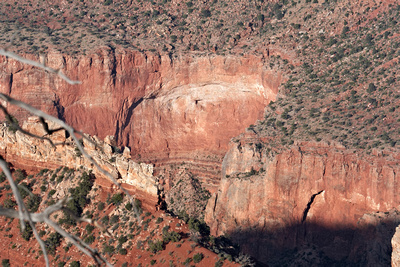

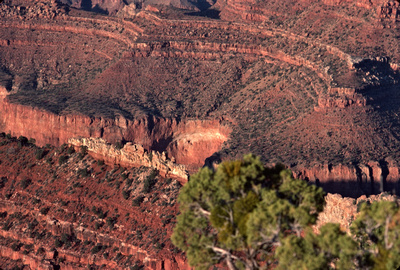

A recent scanned of a 1977 Carousel - Enjoy.
Zion National Park
Imagine a hand almost the size of France, miles below the Four Corners (Arizona, Utah, New Mexico and Colorado) slowly lifting sediments deposited in the North American inland sea and sand dunes of a desert like the Sahara created eons ago. Slow as it went, it raised the Plateau by over 10,000 feet (3,000 m.)
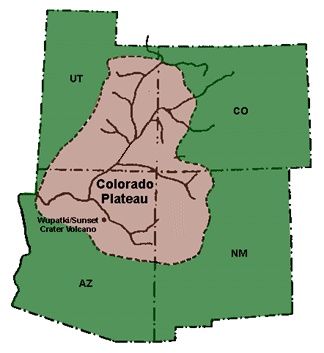
A series of coincidences has created the beautiful, savage and hostile landscapes we now explore in National and State Parks in these four southern States.
The most interesting coincidence is the fact that the hand lifted the Plateau in one piece, and at almost exactly the rate of water erosion in the Plateau.
Zion, our last National Park visited this trip, is a great example of this coincidence. (And so is the Grand Canyon -1977.)
The tiny Virgin river and its tributaries, is responsible for carving a half-mile deep gorge in Zion National Park. As the Plateau rose an inch, the Virgin river dug an inch too... slowly gouging the rocks around to leave peaks and mesas as colourful as they are visually impressive. The water followed the cracks created by tectonic forces and the ridges of ancient dunes sculpting stunning mesas, criss-crossing them as giant checkers.
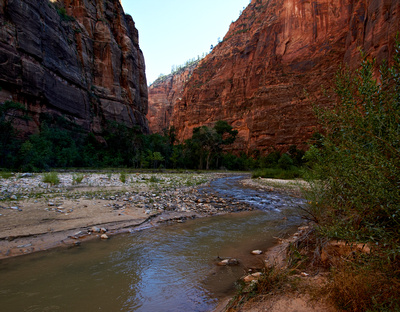

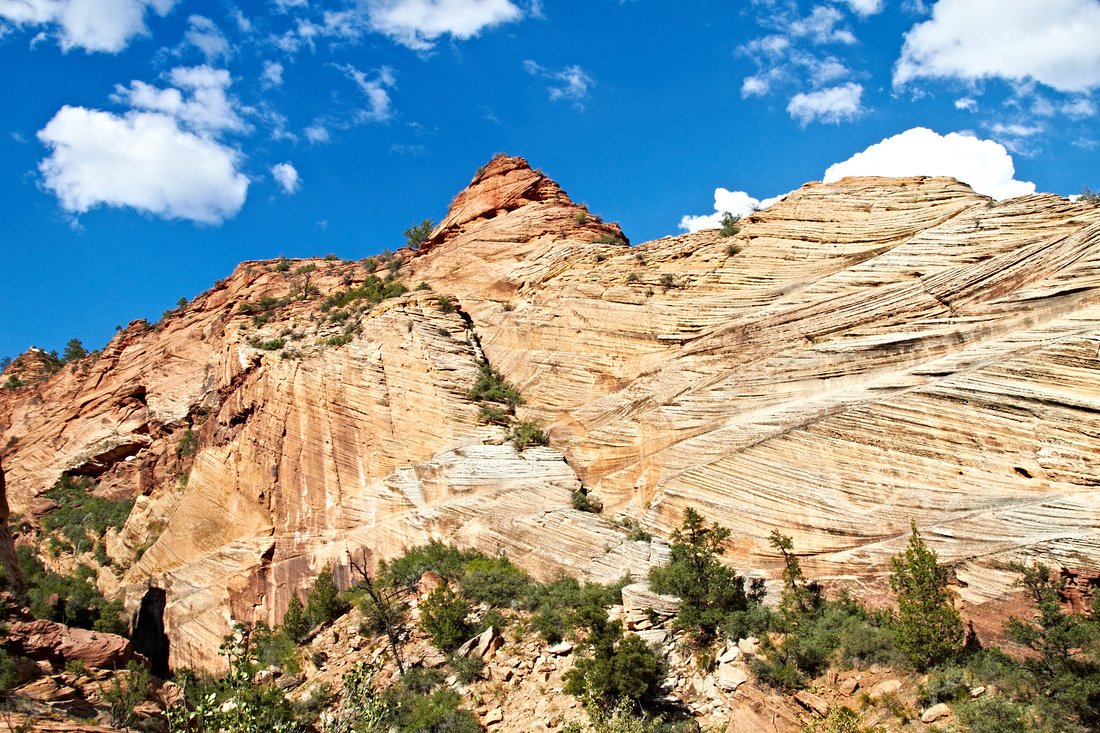

We are in the canyon, following a steep river surrounded by rock walls covered by desert patina, red ochre and deep black. The springs are all over, as this is the rainy season, bringing flowering plants in these water logged oasis.
It is easy to feel that this is a comfortable place until a flash flood raises the water level by 15 to 30 feet, rushing with boulders the size of a large house and destroying everything on its path. We were lucky enough not to experience it; the Park had to close a few times because of these flash floods.
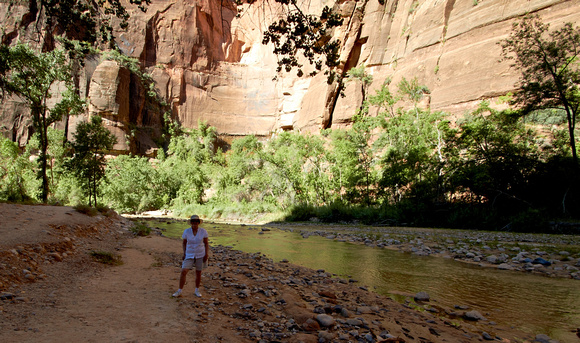

We have been to Zion National Park in the 70's Zion 1977, before the shuttle..., in 2007 and now in 2012. We certainly prefer Spring or Fall visits. This year, it was August, and we shortened our stay because of the unpleasant 40 C (100 F) humid heat at noon and the crowds...Even evenings are warmer that we care for.
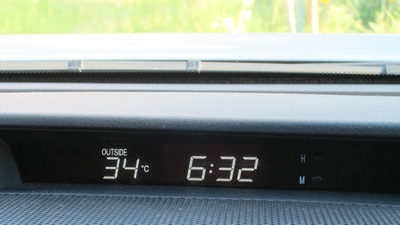

Scanning Interlude
The recent visit to Zion National Park, in 2012, reminded us of our first, in late Spring 1977, 35 years ago.
As I fiddled with the scanning parameters, trying to extract pixels, not dust nor grain, I was surprised by the quality of the outcome. The camera was a Konica, with Automatic Metering, but manual focus and I cannot remember if I had more than the standard 50 mm lens on it on that trip.
Of all the Single Lens Reflexes (SLR) we owned (Konica, Minolta, Canon), it is the one that took the most pictures before the advent of D... SLR. Earlier Canon DSLR were very close.
Today, I feel that the Canon 7D with a 24-105mm zoom is reminiscent of that early Konica from the 70's. The Zion blue skies are always a treat. Deep blue with touches of white. When storms are roaming, the carved details fade away, leaving only shapes and forms.
The interesting part is that the passion we (Louise and I) had for landscape photography has not abated over the years. When I look at these slides, I can visualize the images that took anchor in our memory; and why we return to these landscapes over and over.
Sometimes I wonder if we made progress. Of course, we now have a trailer, instead of a tent, tablets instead of paper notepads, digital photographic equipment and many other goodies that we could not dream of in the 70's.
But are our artistic senses better? Do we look and see these unique landscapes in ways which are more refined, telling more to those who look at our pictures?
This gives me food for reflection. We are now planning a longer Western trip in 2013. These scans and how we compare what we saw in 1977 and today will serve as guideposts for what we can see and do then.
The issue is not better quality (nice to have), but conveying beauty, immensity, and the urge to go and visit personally now.
We hope you will enjoy the three galleries that you can reach by clicking on the pictures above.
